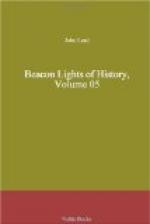But the monks, ignorant and degenerate as they were, guarded what little literature had escaped the ruin of the ancient civilization. They gave the only education the age afforded. There was usually a school attached to every convent, and manual labor was shortened in favor of students. Nor did the monks systematically and deliberately shut the door of knowledge against those inclined to study, for at that time there was no jealousy of learning; there was only indifference to it, or want of appreciation. The age was ignorant, and life was hard, and the struggle for existence occupied the thoughts of all. The time of the monks was consumed in alternate drudgeries and monotonous devotions. There was such a general intellectual torpor that scholars (and these were very few) were left at liberty to think and write as they pleased on the great questions of theology. There was such a general unanimity of belief, that the popes were not on the look-out for heresy. Nobody thought of attacking their throne. There was no jealousy about the reading of the Scriptures. Every convent had a small library, mostly composed of Lives of the saints, and of devout meditations and homilies; and the Bible was the greatest treasure of all,—the Vulgate of Saint Jerome, which was copied and illuminated by busy hands. In spite of the general ignorance, the monks relieved their dull lives by some attempts at art. This was the age of the most beautiful illuminated manuscripts. There was but little of doctrinal controversy, for the creed of the Church was settled; but pious meditations and the writings of noted saints were studied and accepted,—especially the works of Saint Augustine, who had fixed the thinking of the West for a thousand years. Pagan literature had but little charm until Aristotle was translated by Arabian scholars. The literature of the Church was puerile and extravagant, yet Christian,—consisting chiefly of legends of martyrs and Lives of saints. That literature has no charm to us, and can never be revived, indeed is already forgotten and neglected, as well it may be; but it gave unity to Christian belief, and enthroned the Christian heroes on the highest pedestal of human greatness. In the monasteries some one of the fraternity read aloud these Lives and Meditations, while the brothers worked or dined. There was no discussion, for all thought alike; and all sought to stimulate religious emotions rather than to quicken intellectual activity.




